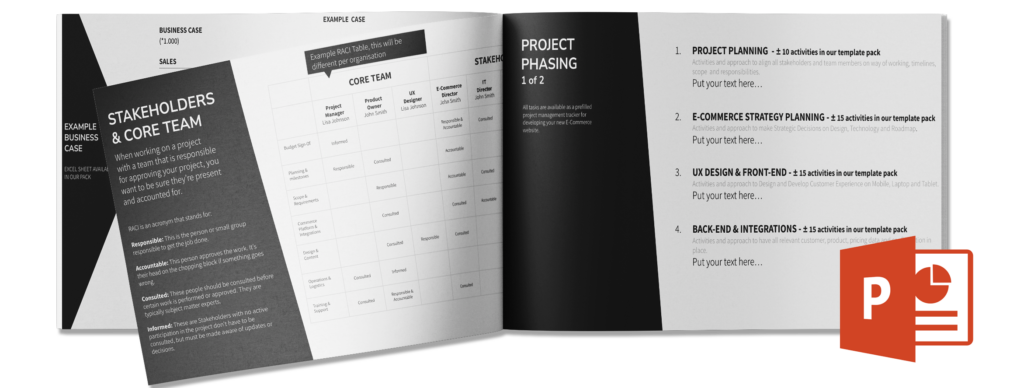Making a E-Commerce Website Project Plan, and need to integrate a PIM to get your website live? Be sure to read this article and check our free downloads.
One key component of a robust e-commerce infrastructure is a Product Information Management (PIM) system. This comprehensive blog post will explore the relationship between PIM and e-commerce, delve into the pitfalls of implementation and integration, and provide strategies to mitigate these challenges.
We’ll also discuss the roles involved in a successful PIM project and emphasize the importance of content management and quality. This guide is tailored for project managers tasked with overseeing PIM implementation and leading a team of experts.
1. What is a PIM and how does it relate to E-Commerce?
Product Information Management (PIM) is a centralized system designed to collect, manage, enrich, and distribute product information across various sales and marketing channels. In the context of e-commerce, a PIM serves as the single source of truth for all product-related data, ensuring consistency and accuracy across all touchpoints.
Key features of a PIM system include:
- Centralized data storage
- Multi-channel distribution
- Data enrichment capabilities
- Workflow management
- Version control
- Integration with other systems (e.g., ERP, CMS, e-commerce platforms)
The relationship between PIM and e-commerce is symbiotic. A PIM system feeds accurate, enriched product information to e-commerce platforms, enhancing the online shopping experience. This, in turn, can lead to increased conversions, reduced returns, and improved customer satisfaction.

2. Pitfalls and Mitigations When Implementing a PIM
Implementing a PIM system can be a complex process with several potential pitfalls. Be sure to pay attention to this in your E-Commerce Projectplan.
Download your Template: Free E-Commerce Website Projectplan
Here are some common challenges and strategies to mitigate them:
a) Data Migration and Cleansing
Pitfall: Migrating existing product data to a new PIM system can be time-consuming and error-prone, especially if the current data is inconsistent or incomplete.
Mitigation:
- Conduct a thorough data audit before migration
- Develop a clear data governance strategy
- Use data cleansing tools and techniques
- Implement a phased migration approach
- Validate data post-migration
b) Integration Complexity
Pitfall: Integrating PIM with existing systems (ERP, CMS, e-commerce platforms) can be technically challenging and may lead to data silos if not done correctly.
Mitigation:
- Develop a detailed integration plan
- Use APIs and middleware for seamless integration
- Conduct thorough testing of all integrations
- Implement real-time data synchronization where possible
- Consider a headless commerce approach for greater flexibility
c) User Adoption
Pitfall: Resistance to change from team members can hinder the successful implementation of a PIM system.
Mitigation:
- Involve key stakeholders from the beginning
- Provide comprehensive training programs
- Highlight the benefits of PIM for individual roles
- Implement a change management strategy
- Gather and act on user feedback
d) Scope Creep
Pitfall: The project scope can easily expand beyond initial parameters, leading to delays and budget overruns.
Mitigation:
- Define clear project objectives and deliverables
- Use agile project management methodologies
- Implement a robust change control process
- Regularly review and adjust the project plan
- Prioritize features based on business value
e) Content Quality Issues
Pitfall: Poor quality or inconsistent product content can undermine the benefits of a PIM system.
Mitigation:
- Establish clear content guidelines and standards
- Implement automated content validation rules
- Use digital asset management (DAM) integration for rich media
- Conduct regular content audits
- Invest in content enrichment tools and services
3. Experts to include in your E-Commerce Projectplan
Implementing a Product Information Management (PIM) system as part of an e-commerce project plan requires a well-orchestrated effort from various teams and roles across different project phases.
In the initial planning phase, the Project Manager works closely with Business Analysts and key stakeholders to define project scope, objectives, and timelines. They collaborate with the E-commerce Specialist to ensure the PIM strategy aligns with overall e-commerce goals.
As the project moves into the design phase, Data Architects and UX/UI Designers take center stage, working together to create a data model and user interface that meets both technical requirements and user needs.
The implementation phase sees Integration Specialists and IT Security experts joining forces to ensure smooth system integration and robust data protection. Meanwhile, Content Managers begin to develop content strategies and guidelines in preparation for data migration.
During the testing and quality assurance phase, QA Specialists collaborate with all teams to ensure system functionality, data accuracy, and user acceptance. As the project nears completion, Change Management Specialists work hand-in-hand with the Project Manager and department heads to facilitate user adoption and training.
Post-launch, the focus shifts to ongoing optimization, with Content Managers, E-commerce Specialists, and Data Analysts working together to continually improve product information quality and its impact on e-commerce performance.
To help you navigate this complex process, we’ve created a comprehensive e-commerce project plan template that outlines these phases, roles, and key tasks in detail. Download our Free E-Commerce Project Plan Template to kickstart your PIM implementation journey and ensure you have all the essential elements covered from start to finish.

A successful PIM implementation requires a diverse team of experts. Key roles include:
a) Project Manager
- Oversees the entire implementation process
- Coordinates between different teams and stakeholders
- Manages timelines, budgets, and resources
- Ensures alignment with business objectives
b) Business Analyst
- Gathers and documents business requirements
- Maps current processes and identifies areas for improvement
- Helps define the future state of product information management
c) Data Architect
- Designs the data model for the PIM system
- Ensures data integrity and consistency
- Plans data migration strategies
d) Integration Specialist
- Develops and implements integration strategies
- Ensures smooth data flow between PIM and other systems
- Troubleshoots integration issues
e) Content Manager
- Oversees content creation and enrichment processes
- Ensures adherence to content guidelines and standards
- Manages content workflows and approvals
f) UX/UI Designer
- Designs user interfaces for PIM system
- Ensures intuitive user experience for content creators and managers
g) Quality Assurance Specialist
- Develops and executes test plans
- Ensures system functionality and data accuracy
- Identifies and reports bugs and issues
h) Change Management Specialist
- Develops strategies for user adoption
- Manages communication around the PIM implementation
- Provides training and support for end-users
i) IT Security Specialist
- Ensures data security and compliance
- Implements access controls and authentication measures
j) E-commerce Specialist
- Provides insights on e-commerce best practices
- Ensures PIM aligns with e-commerce strategy and requirements
4. The Role of Content Management and Quality in your E-COmmerce Project plan
Content management and quality are crucial aspects of a successful PIM implementation and ongoing e-commerce operations. Here’s how to ensure high-quality content management:
a) Establish Content Guidelines
- Develop clear, comprehensive guidelines for product descriptions, attributes, and digital assets
- Ensure guidelines align with brand voice and e-commerce best practices
b) Implement Workflow Management
- Design efficient content creation and approval workflows
- Use PIM system features to automate and streamline processes
c) Leverage AI and Machine Learning
- Utilize AI tools for content generation and enrichment
- Implement machine learning algorithms for content categorization and tagging
d) Regular Content Audits
- Conduct periodic reviews of product content
- Use analytics to identify underperforming content
e) Continuous Improvement
- Gather feedback from customers and sales teams
- Iteratively improve content based on performance metrics
f) Multi-language and Localization
- Develop processes for managing content across multiple languages and regions
- Ensure consistency in translations and cultural appropriateness
g) SEO Optimization
- Integrate SEO best practices into content creation processes
- Use PIM features to manage SEO-relevant attributes
h) Rich Media Management
- Implement a robust Digital Asset Management (DAM) system
- Ensure high-quality images, videos, and other rich media for all products
i) Version Control and History
- Maintain a clear history of content changes
- Implement version control for easy rollback and auditing
j) Performance Monitoring
- Use analytics to track the impact of product content on e-commerce performance
- Continuously optimize based on data-driven insights
Getting your E-Commerce plan right
Implementing a PIM system as part of your e-commerce project plan is a complex but rewarding endeavor. By understanding the potential pitfalls and involving the right experts, you can ensure a smooth implementation that drives e-commerce success. Remember that content management and quality are ongoing processes that require continuous attention and improvement.
As you embark on your PIM implementation journey, consider using an e-commerce project plan template to guide your efforts. This will help ensure you cover all crucial aspects of the implementation, from initial planning to post-launch optimization.
By following this comprehensive guide, you’ll be well-equipped to lead a successful PIM implementation that enhances your e-commerce operations, improves customer experiences, and drives business growth.


